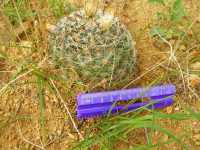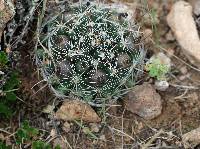Plants usually unbranched. Roots: upper portion of primary root somewhat thickened and succulent proximally, otherwise fibrous. Stems flat-topped or spheric to short cylindric, ± flaccid; tubercles (5-)6-15(-17) mm; axils appearing naked; cortex and pith mucilaginous; latex absent. Spines 19-31(-34) per areole, usually white or brown-and-white (rarely bright reddish brown), glabrous (to hoary); radial spines (13-)15-23(-31) per areole, in 1 series, bristlelike, stiff; central spines 1-2(-4) per areole, porrect or strongly projecting, all hooked, (7.5-)10-20(-31) × 0.2-0.4 mm; subcentral spines 0 [several in M. barbata]. Flowers (1.5-)2-3.5(-3.9) × (1.2-)1.8-3(-4.2) cm; outermost tepal margins long fringed, reaching 1 mm; inner tepals usually white, cream, pale tan, greenish white, or pale rose-pink, sometimes appearing pale orange proximally due to reflection of yellow anthers, usually with ± sharply defined pink midstripes (often suffused with brown, yellow, pink, red, purple, or green, darkest and brightest distally on most plants), (7.5-)12-17(-21) mm; stigma lobes green or yellow-green. Fruits green or purple, ovoid or obovoid, (6-)10-16(-22) × (4-)6-12(-13) mm, juicy throughout; floral remnant persistent. Seeds chocolate brown with darker reticulation, 1.3 × 0.9 mm, pitted; testa hard; anticlinal cell walls straight; interstices conspicuously narrower than pit diameters; pits bowl-shaped. 2n = 22.
Flowering spring; fruiting fall. Semidesert grasslands, interior chaparral, pinyon-juniper and oak woodlands, crevices, boulders, canyon sides and gravelly igneous substrates; (800-)1400-2000 m; Ariz., N.Mex.
Mammillaria viridiflora is closely related to M. barbata Engelmann of Mexico, which has priority if the species are combined.







